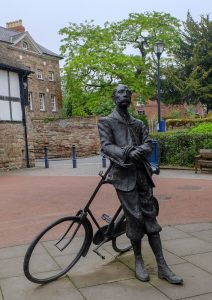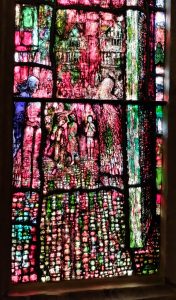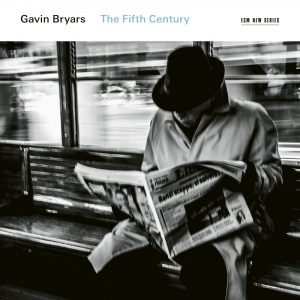In all things – at all times – and in so many ways

Walking in the steps of Edward Elgar, Thomas Traherne, and Gavin Bryars
I recently walked down Broad Street in the heart of Hereford and passed a neo-classical church, St. Francis Xavier’s, built in 1837. From 1904 to 1911, the great composer, Sir Edward Elgar, lived in Plas Gwyn, a house in the leafy eastern end of Hereford. In between commissions (and he was indeed famous by then) Elgar spent many hours at the keyboard in the organ loft of this church. Like his father before him, his introduction to music was as an organist at St. George’s church (also Jesuit-run) in nearby Worcester. Although founded by the Jesuits, shortly before Elgar arrived in Hereford, the Benedictines took over St. Xavier’s.

Source: Kevin Burns
Passing St. Xavier’s, I turned to the left, toward Hereford’s monumental cathedral, founded in 1079. As I approached the Cathedral entrance, Sir Edward Elgar, leaning against his beloved bicycle (“Mr. Phoebus”) greeted me ‒ in bronze.
Elgar’s relationship to the Anglican world was as difficult as his wavering commitment to Catholicism. The pianist and writer, Stephen Hough, explained in a radio essay for the BBC, that Elgar felt “his faith was an impediment to his career.”
When, in 1900, Elgar chose to set the words of Blessed John Henry Newman to music, “At the front of the score to Gerontius,” explains Hough, “he wrote the bold letters: A.M.D.G. (Ad Majorem Dei Gloriam) To the Greater Glory of God.”
As the years passed, Elgar’s “attitude towards his Catholic faith degenerated from discomfort and indifference to fierce antipathy,” says Hough. And in 1934, in his final hours, Elgar had to be convinced to allow a priest to anoint him.

Source: Kevin Burns
Amid the many shrines and monuments of Hereford cathedral is the Audley Chapel, a tiny alcove that demands total silence. Inside are four dramatic stained-glass windows by a contemporary artist Tom Denny. In vivid green and reds, I encountered the etched figure of Thomas Traherne. Traherne? He was born in Hereford and after studying at Oxford was ordained into the Anglican church.
A strident anti-Catholic (Roman Forgeries, published in 1673), he is better known as the metaphysical poet and mystic whose most famous works and meditations were discovered long after his death.
Back in Ottawa, beguiled by shadowy Traherne, I began a search. Not an easy task. Among the (few) books I also came across a Traherne-based composition by Gavin Bryars. The Fifth Century is his setting of selections from the fragments Traherne’s final work discovered in 1908.

Source: Courtesy of ECM.
“As sure as there is a Space infinite, there is a Power, a Bounty, a Goodness, a Wisdom infinite, a Treasure, a Blessedness, a Glory…” (#4)
“Eternity magnifies our joys exceedingly… Like the sun we dart our rays before us, and occupy those spaces with light and contemplation which we move towards, but possess not with our bodies.” (#8)
“The essence of God … being all light and knowledge, love and goodness, care and providence, felicity and glory, a pure and simple act… is wholly busied in all parts and places of His dominion, perfecting and completing our bliss and happiness.” (#10)
In the CD booklet, music analyst Brian Morton describes Bryars as “a latter-day Metaphysical” and says his music has the power to make “eternity audible, and in the process [make] the words of an obscure shoemaker’s son from Hereford (even this isn’t certain) resonate with the present age where the boundaries of physics and metaphysics are blurred once more.” Incidentally, the CD won this year’s Grammy for best ensemble performance.
And so a journey continues, step by step.
++++++++++++++++++++
To hear brief excerpts from “The Fifth Century” this is the ECM catalogue page:
https://www.ecmrecords.com/catalogue/1476688986/the-fifth-century-gavin-bryars




No Comments